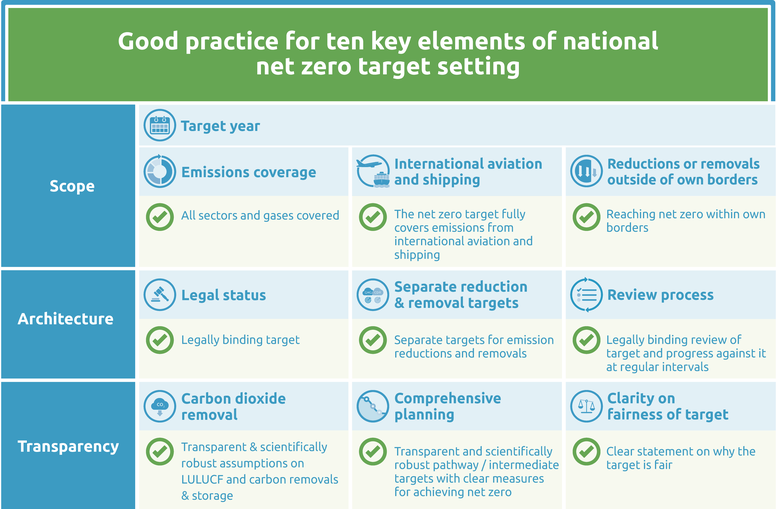Net zero targets
Summary
We evaluate the net zero target as: Poor.
In March 2023, the UAE took another step to confirm its net zero target as a domestic policy objective by signing the “UAE Governments Net Zero 2050 Charter”. This announcement does not provide any further details on the UAE’s strategy towards reaching net zero, but it signals the UAE’s intensifying commitment to net zero in the run up to its COP presidency.
During COP27 in November 2022, the UAE presented its “National Net Zero by 2050 Pathway”. In 2021, the UAE had already announced its intention to reach net zero by 2050, as part of the UAE Net Zero 2050 strategic initiative, becoming the first Middle Eastern and Gulf country to do so.
To date, these announcements lack information on scope, target architecture, and transparency. The emissions coverage remains unclear—the UAE needs to specify whether it covers CO2 emissions only or all greenhouse gases. It also needs to provide information on the assumptions taken for actual emissions reductions and removals. As of March 2023, the UAE has yet to submit a long-term strategy to the UNFCCC.
The UAE lists renewable and nuclear energy as important components of its strategy to reach the net zero target. It also refers to a “gradual reduction” in the use of fossil fuels, but it makes no mention of its plans to increase coal-fired power generation as part of its 2050 Energy Strategy. There are also uncertainties around the extent to which carbon capture and storage (CCS) will be used.
The UAE needs to improve its net zero target in terms of transparency, as it lacks detailed information.
Ten key elements
Scope
- Target year – The UAE aims to reach net zero by 2050.
- Emissions coverage – The UAE specifies in its latest NDC that the target covers “the entire UAE economy” which we interpret as covering all sectors and gases.
- International aviation and shipping – The UAE provides no information on its intention to cover international aviation and shipping.
- Reductions or removals outside of own borders – The UAE provides no information on its intention to use international offset credits to meet its net zero target.
Target architecture
- Legal status – In March 2023, the Cabinet of the United Arab Emirates signed the “UAE Governments Net Zero 2050 Charter”. The UAE had previously announced its net zero target as part of the UAE Net Zero by 2050 strategic initiative in 2021 and presented some additional information on it at COP27 (Ibrahim & Saleh, 2022).
- Separate reduction & removal targets – In its 2022 NDC, the UAE states that its Net Zero Strategy will include interim sectoral emission reduction targets. In its press release at COP27, the UAE presented some economy-wide emission reduction targets for 2030, 2040, and 2050, but does not present a clear baseline and scope for such targets, nor does it clarify whether the 100% reduction target for 2050 will include emission removals (Ibrahim & Saleh, 2022).
- Review process – In its 2022 NDC, the UAE mentioned it would develop sector-specific baseline scenarios to then develop cost-effective pathways to reach net zero. This 2050 roadmap is set to include interim, sectoral emissions reduction targets to be updated every five years (Government of the UAE, 2022).
Transparency
- Carbon dioxide removal – Though the UAE Ministry of Climate Change & Environment states it plans to use direct air capture (DAC) and carbon capture, utilisation, and sequestration (CCUS), it provides no transparent or specific information on its planned carbon dioxide removals.
- Comprehensive planning – At COP27, the UAE presented its “National Net Zero by 2050 Pathway”. This pathway provides absolute emissions reduction targets for 2030 and 2040 and a net zero target for 2050. The UAE does not provide detailed measures on its pathway.
The Net Zero by 2050 strategic initiative refers to a larger-scale deployment of renewable and nuclear energy as a key pillar to achieve net zero by 2050.
For this purpose, Sheikh Mohammed bin Rashid Al Maktoum has pledged around USD 160bn in energy sector investments over the next 30 years (Lo, 2021). There is no mention of the planned expansion of coal-fired power generation under the 2050 Energy Strategy. - Clarity on fairness of target – The UAE provides no information on its intention to explain the target’s fairness.
Good practice
The Climate Action Tracker has defined the following good practice for all ten key elements of net zero targets. Countries can refer to this good practice to design or enhance their net zero targets.
Further analysis
Latest publications
Stay informed
Subscribe to our newsletter







